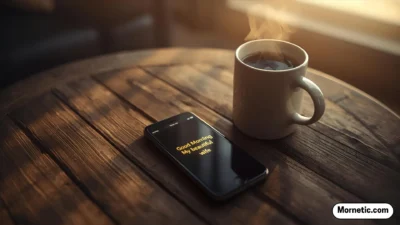Waking up and greeting someone is one of the first social interactions we have each day; as a result, it sets the tone for everything that follows. Therefore, if you’re planning a trip to Brazil or Portugal, connecting with Portuguese-speaking friends, or simply learning a beautiful new language, knowing how to say “good morning” is your essential first step. Ultimately, it’s more than just words; it’s a key that unlocks warmer interactions and shows respect for the local culture.
But here’s a fun secret: “bom dia” is just the beginning! 🤫 In fact, the Portuguese language, especially in vibrant Brazil, is full of colorful, friendly, and informal ways to greet people in the morning. Consequently, this guide will take you far beyond a simple “bom dia.” First, we will explore formal and casual greetings; then, we’ll teach you how to respond like a native, and finally, dive into the cultural nuances that will make your “good morning” truly shine. So, get ready to learn, practice, and impress!
The Essential Meaning and Use of “Bom Dia”
Let’s start with the absolute cornerstone of morning greetings in Portuguese. Specifically, “Bom Dia” is your go-to phrase, and understanding its depth is crucial for any learner or traveler.
- Literal Translation. “Bom” means “good,” and “Dia” means “day.” Therefore, “Bom Dia” translates directly to “Good Day.”
- Morning-Only Usage. Unlike in English, where “Good day” can sound a bit formal or old-fashioned, “Bom Dia” in Portuguese is used specifically for the morning hours.
- The Standard Timeframe. You typically use “Bom Dia” from sunrise until around noon or lunchtime (usually 12 p.m. to 1 p.m.).
- Formal and Informal Flexibility. The beauty of “Bom Dia” is that it works in almost every context. For example, you can use it with your boss, a stranger on the street, or your family at the breakfast table.
- It’s a Complete Sentence. Just like in English, you can simply say “Bom Dia!” as a full greeting. In other words, you don’t need to add anything else for it to be grammatically correct and perfectly polite.
- A Note on Friendliness. In Brazil, saying “Bom Dia” with a smile is a sign of good manners. For instance, it’s common to greet shopkeepers, receptionists, and people you pass in a hallway.
- Pronunciation Guide. Don’t say “bom dee-ah.” Instead, the correct Brazilian Portuguese pronunciation is more like “bom JEE-ah,” with a soft, zh-like sound for the ‘d’.
- The Cultural Weight. Ultimately, using “Bom Dia” shows that you are making an effort to connect on a local level. It’s a small gesture that is always appreciated.
- The Response. The most common and natural response to “Bom Dia” is to simply say “Bom Dia” back! (We’ll explore more elaborate responses later.)
Now that we’ve broken down the basics, let’s get the pronunciation just right. Otherwise, many learners get tripped up by the unique sounds in Portuguese; however, with a little guidance, you can master it. Specifically, the ‘d’ in “dia” is the key. In Brazilian Portuguese, when a ‘d’ comes before an ‘i’, it softens into a sound similar to the “s” in “pleasure.” So, practice saying “bom JEE-ah.” Remember, a cheerful tone goes a long way! 😊
Furthermore, knowing when to stop using “Bom Dia” is as important as knowing how to say it. Typically, the transition to “Boa Tarde” (Good Afternoon) is not strictly clock-based but rather feel-based. For example, if you’re finishing lunch and it feels like the morning has definitively ended, it’s time to switch. In most urban settings, anything past 12 p.m. is safe territory for “Boa Tarde.” When in doubt, listen to how the people around you are greeting each other.
Beyond the Basics: Other Wonderful Morning Greetings
While “Bom Dia” is the undisputed champion, the Portuguese language offers a rich tapestry of other greetings. As a result, using these can make you sound more natural and help you tailor your greeting to the specific situation.
- Bom Dia, Tudo Bem? This means “Good morning, all well?” Consequently, it’s an extremely common and friendly way to combine a greeting with a “how are you?”
- Olá, Bom Dia! Starting with “Hello” before “Good Morning” adds a little extra warmth and is perfectly natural in conversation.
- Oi, Bom Dia! Similar to “Olá,” but more informal. Specifically, “Oi” is the ubiquitous “hi” of Brazil, and pairing it with “Bom Dia” is very casual and friendly.
- Um Lindo Dia Para Você! This is a beautiful, warm wish that means “A beautiful day to you!” In short, it’s kind and heartfelt.
- Desejando um Bom Dia! This translates to “Wishing you a good morning!” Often, it’s used in text messages or on social media.
- Acordou Com os Pés Direitos? A fun, idiomatic expression that literally means “Did you wake up with your right foot?” In other words, it’s like asking, “Did you get out of the right side of the bed this morning?”
- Como Amanheceu? This means “How did you dawn?” or more naturally, “How are you this morning?” Therefore, it’s a caring way to ask about someone’s state upon waking.
- Bom Dia, Meu Amor. For greeting a loved one, this means “Good morning, my love.” Alternatively, you can substitute “meu amor” with “querido/a” (darling) or “meu bem” (my dear).
- Bom Dia, Pessoal! A great way to greet a group of people, meaning “Good morning, everyone!”
- Um Dia Abençoado! A spiritual and common greeting, meaning “Have a blessed day.”
While “Bom Dia” is your essential tool, these variations are the polish that makes your language skills shine. For instance, walking into a small shop and saying a cheerful “Bom dia, tudo bem?” to the owner is a fantastic way to practice and create a positive connection. Ultimately, it shows you’re not just reciting a phrase but engaging in a real social ritual. Brazilians, in particular, value this kind of personal interaction highly.
Moreover, don’t be afraid of the more poetic greetings like “Um Lindo Dia Para Você.” While you might not use it with a taxi driver, it’s perfect for a close friend, a family member, or in a written note. In essence, these phrases carry emotional weight and can deeply strengthen your relationships with Portuguese speakers. As a result, they demonstrate a level of care and cultural understanding that goes far beyond the basics.
How to Respond to “Bom Dia” Like a Native
You’ve been greeted with a cheerful “Bom Dia!” Now what? Ultimately, knowing how to respond naturally is what separates a textbook learner from a confident speaker. Specifically, your response can be a simple echo or the start of a friendly conversation.
- The Echo. The simplest and most common response is to smile and say “Bom Dia!” right back. In short, it’s always correct and perfectly polite.
- Bom Dia, Tudo Bem? You can turn the greeting back to the other person. “Good morning, all well with you?”
- Tudo Bem! If they ask “Tudo bem?” first, a simple “Tudo bem!” (All well!) is the standard, positive reply.
- Tudo Joia! A fun, informal slang response meaning “Everything’s great!” or “Everything’s cool!” (Literally, “everything’s a jewel”).
- Tudo Tranquilo. This means “Everything’s calm/peaceful.” Therefore, it conveys that things are going smoothly.
- Mais ou Menos. If you’re having an off day, you can respond with “So-so.” Generally, this is an honest and commonly used response.
- E aí? If the greeting was very informal (like an “E aí?”), you can respond with the same “E aí?” or a “Tudo bem?”
- Aqui, Tentando Melhorar. A humble and common response meaning “Here, trying to improve.”
- Bom Dia Para Você Também! A very sweet and explicit response: “Good morning to you too!”
- Como Você Está? You can bypass the simple “tudo bem” and ask more formally, “How are you?”
Responding appropriately is about matching the energy and formality of the initial greeting. For example, in a fast-paced office, a quick “Bom Dia, tudo joia!” as you walk by is efficient and friendly. On the other hand, in a more formal meeting, a firm and clear “Bom Dia, prazer” (Good morning, pleased to meet you) when introduced to someone new is more suitable. The key is to listen and mirror.
Furthermore, your non-verbal communication is just as important as the words you choose. For instance, a genuine smile, direct eye contact, and a friendly tone of voice can make even the simplest “Bom Dia!” sound warm and sincere. Additionally, in Brazilian culture, physical touch like a handshake for a first meeting or a kiss on the cheek among friends often accompanies these greetings. Therefore, observing and following the lead of those around you is the best strategy.
Cultural Nuances: Greeting Etiquette in Brazil and Portugal
Language is a reflection of culture; therefore, how you say “good morning” can vary dramatically between different Portuguese-speaking countries. Understanding these subtleties will prevent awkward moments and enrich your interactions.
- The Brazilian Warmth. In Brazil, greetings are generally warm, expressive, and often involve physical touch. So, don’t be surprised by hugs or cheek kisses among acquaintances.
- The Portuguese Formality. In Portugal, initial interactions can be more formal and reserved. Typically, a handshake is common, and cheek kisses are usually for friends and family.
- The Use of “Você” vs. “O Senhor/A Senhora.” In Brazil, “você” (you) is widely used. However, in Portugal, it’s more polite to use “O Senhor” (for a man) or “A Senhora” (for a woman) with someone older or in a formal context.
- Greeting Everyone Individually. In smaller groups, especially in Brazil, it is considered polite to greet each person individually with a “Bom Dia” rather than a general call to the whole room.
- The Importance of “Por Favor” and “Obrigado/a.” Good manners are paramount. Therefore, always pair your greetings with “please” and “thank you.”
- Time Perception is Fluid. The switch from “Bom Dia” to “Boa Tarde” is not a hard rule. Sometimes, in a more relaxed setting, “Bom Dia” might be used a little past noon.
- The Power of a Smile. Regardless of the country, a sincere smile is universal. In fact, it makes any greeting, no matter how accented, feel genuine and friendly.
- In Professional Settings. In a business context, use formal greetings until invited to be more informal. For example, use titles and last names (“Bom Dia, Doutor Silva”).
- Acknowledging People in Public. It’s common to say “Bom Dia” to shopkeepers, waitstaff, and people you share a small space with (like an elevator).
The cultural gap between Brazil and Portugal is a classic example of how the same language can be wrapped in different social customs. As a result, a Brazilian might perceive a Portuguese person as cold at first, while a Portuguese person might see a Brazilian’s effusiveness as overly familiar. Ultimately, neither is wrong; they are simply different. Therefore, as a visitor, leaning slightly towards formality when you are unsure is a safe and respectful approach, especially in Portugal.
Additionally, the concept of “jetitinho” or friendliness is key in Brazil. For example, taking an extra 30 seconds to ask “Como vai?” after saying “Bom Dia” can build rapport much faster than a rushed greeting. This reflects a culture that values personal connection. In both countries, however, the effort is what counts. Consequently, your attempt to greet someone properly in their native language will almost always be met with encouragement and appreciation, breaking down barriers and opening doors to more meaningful conversations. 🌍
Common Mistakes to Avoid When Saying Good Morning
When you’re learning, making mistakes is part of the process! But being aware of common pitfalls can help you sound more polished and avoid any unintended confusion or rudeness.
- Mispronouncing “Dia.” Avoid the hard English “dee-ah.” Instead, remember the soft “JEE-ah” sound.
- Using “Boa Manhã.” This is a direct translation from English or French, but it is not used by native speakers. Therefore, always use “Bom Dia.”
- Being Overly Informal Too Soon. Using slang like “E aí” or “Fala” with someone you’ve just met or who is in a position of authority can be seen as disrespectful.
- Forgetting the Cultural Context. Ignoring local customs, like not making eye contact or refusing a customary cheek kiss (in Brazil) can create distance.
- Not Greeting Back. Ignoring a “Bom Dia” is considered very rude. So, always acknowledge a greeting, even with a simple smile and nod if you’re in a hurry.
- Using the Wrong Greeting for the Time. Using “Bom Dia” at 3 p.m. will instantly mark you as a foreigner. Hence, pay attention to the time of day.
- Keyword Stuffing Your Greeting. In real life, you don’t need to say “Bom Dia, como vai você, tudo bem?” all at once. Otherwise, it sounds unnatural. Instead, pick one or two elements.
- Speaking Too Quietly. Greetings are a social affirmation. Therefore, say your “Bom Dia” with confidence and a clear voice!
- Translating Idioms Literally. Saying “Good morning, did you sleep well?” directly translated might be understood, but a native is more likely to say “Como dormiu?”
One of the most frequent errors learners make is the direct translation “Boa Manhã.” Although it feels logical, it’s simply not part of the living language. Therefore, sticking to “Bom Dia” is crucial for sounding authentic. Think of it as learning that in English, we say “Good morning,” not “Good morn.” In other words, it’s a set phrase that you must learn as a whole.
Another subtle point is the level of enthusiasm. For example, a mumbled, downward-looking “bom dia” can come across as unfriendly or disinterested, even if you’re just shy. However, in the context of Portuguese-speaking cultures, especially Brazil, putting a little energy into your greeting makes a world of difference. Ultimately, it signals that you are happy to engage with the other person. So, stand up straight, smile, and project your voice kindly. As a result, you’ll find people are much more receptive and helpful.
Ready-to-Use Portuguese Greeting Cheat Sheet
Here is a quick, copy-paste friendly list of the essential phrases from this article. Therefore, save it, print it, or keep it on your phone for easy reference! 📝
Formal & Standard Greetings
- Bom Dia! (Good Morning!)
- Olá, Bom Dia! (Hello, Good Morning!)
- Bom Dia, como vai? (Good Morning, how are you?)
- Bom Dia, tudo bem? (Good Morning, all well?)
- Um lindo dia para você! (A beautiful day to you!)
Informal & Slang Greetings
- Oi, Bom Dia! (Hi, Good Morning!)
- E aí? (What’s up?)
- Fala! (Speak! / Hey!)
- Opa, Bom Dia! (Hey, Good Morning!)
- Tudo joia? (Everything cool?)
How to Respond
- Bom Dia! (Good Morning!)
- Tudo bem! (All well!)
- Tudo joia! (Everything’s great!)
- Tudo tranquilo. (Everything’s calm.)
- E aí? / Tudo bem! (What’s up? / All well!)
Key Phrases for Different Times
- Bom Dia (until noon)
- Boa Tarde (afternoon until early evening)
- Boa Noite (evening and night)
Conclusion
In conclusion, mastering the art of saying “good morning in Portuguese” is so much more than memorizing two words. First, it’s about embracing “Bom Dia” as your essential tool, then building upon it with friendly variations like “Tudo bem?” and casual slang like “E aí?”. Furthermore, it’s about understanding the cultural heart behind the greetings—the warmth in Brazil, the formality in Portugal, and the universal importance of a smile. 🤗
Now that you have this knowledge, you know how to respond naturally, avoid common mistakes, and use the right phrase for the right time and person. Ultimately, this knowledge is a powerful gift. As a result, it transforms you from a silent observer into an active participant, ready to connect with over 260 million Portuguese speakers around the world. So, take a deep breath, practice the pronunciation, and get ready to greet your next morning with a confident and cheerful “Bom Dia”!

Grace is a lifestyle writer from California who loves starting mornings with positivity. At Mornetic, she shares uplifting quotes and cheerful messages to brighten your day.




